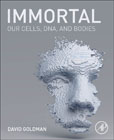
In recent times, the boundary between living and non-living has been blurred by advances in genomics, cell biology, and molecular neuroscience, whereby humans are repaired, enhanced, or made anew. Scientists and physicians are now able to keep cells, organs, and bodies alive indefinitely; and return cells or DNA to our bodies and make new cells for the purpose of treating disease or growing new tissue. Meanwhile, trans-human technologies create illusions of immortality. Immortal: Our Cells, DNA, and Bodies synthesizes what we know about life and death from a genetic, molecular, and cellular perspective; demarcates our limits of knowledge; and forces us to ask new questions. Here, award-winning researcher, physician, and NIH Lab Director David Gold Goldman examines in-depth three keys to understanding the nature and continuity of life: 1) epigenetic (ephemeral) vs genetic (durable) transgenerational memory; 2) life's cellular nature, and the ability to make bodies from cells; and 3) the distinction between bodies and persons. Grounded in recent scientific evidence and real-life cases that test our historical understanding of life and death, Goldman probes the nature of molecular continuity in the face of mortal extinction, encompassing how changes to the DNA code can be both long lasting and transgenerational, and the continuous nature of cellular and molecular information transmission. In tying these themes together, Immortal asks us to apply fresh scientific concepts to examine, for ourselves, the continuity of being in the face of mortality. Applies recent genetic, molecular, and cellular findings to examine the boundaries between living and non-living, and between person and non-personExamines the significance of epigenetic memory and transgenerational inheritance and their role in molecular and precision medicineWritten by a thought-leader in genetic and molecular medicine INDICE: 1. Death2. HeLa: The resurrection of Henrietta Lacks3. Persistence of memory4. Hel: goddess of death and life5. Where self resides6. Our diploid selves7. Our cellular selves8. From molecule to self9. The ancient divide between molecules and self10. Persistence of epigenetic memory11. Altruism, of cell and self12. Shrine or museum?13. Robbing the grave14. Birth15. I am Anastasia
- ISBN: 978-0-323-85692-8
- Editorial: Academic Press
- Encuadernacion: Rústica
- Páginas: 272
- Fecha Publicación: 01/07/2021
- Nº Volúmenes: 1
- Idioma: Inglés
